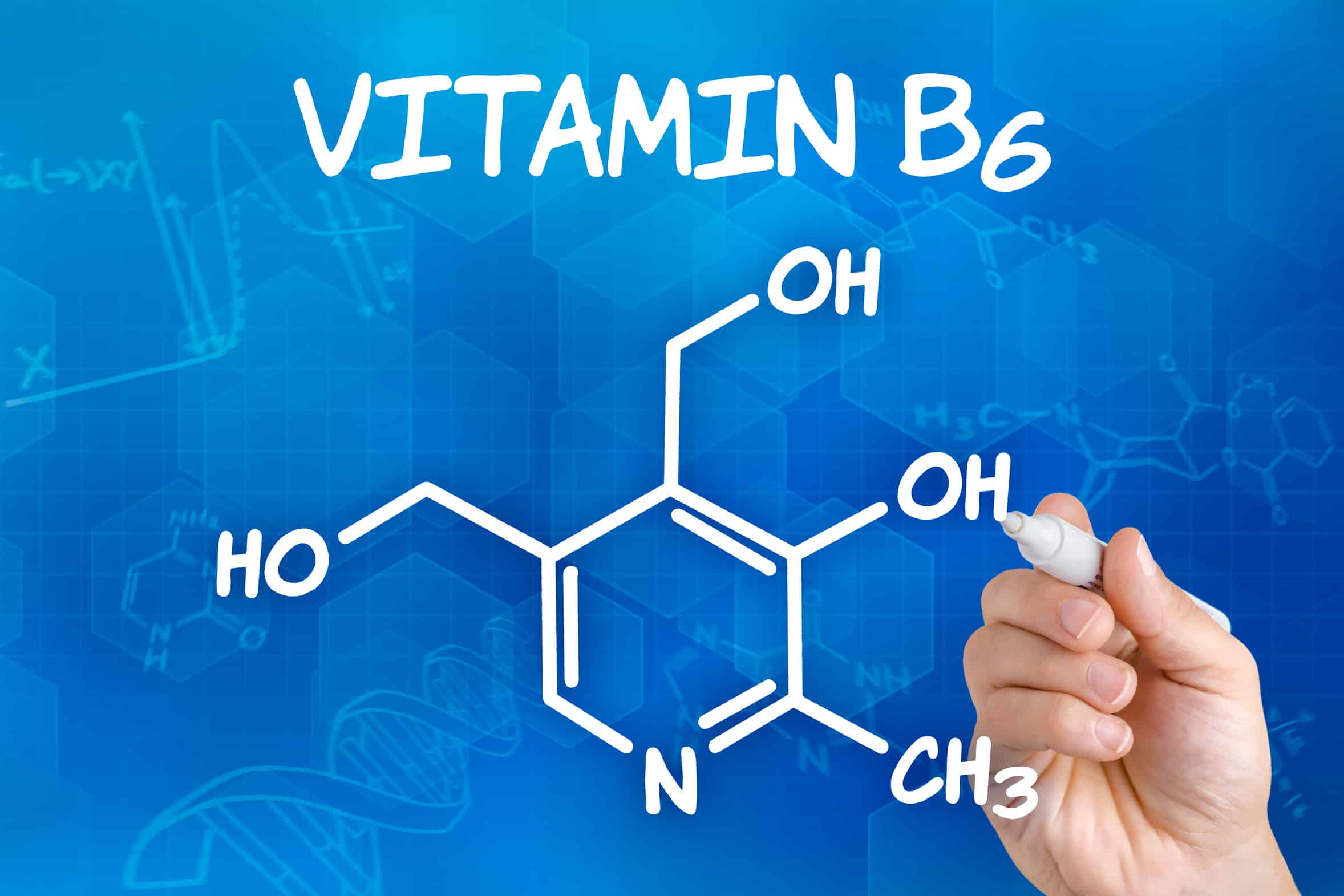Pyridoxine

Pyridoxine is actually a collective name for several chemical compounds that are, however, very similar. The vitamin, often called pyridoxine, comprises the substances pyridoxole, pyridoxal and pyridoxamine and must be supplied to the human body from the outside (usually with food).
Where is vitamin B6 found?
Vitamin B6 is mainly found in the following foods: Milk and dairy products, muscle meat (poultry, beef, pork), fish (mackerel, herring, salmon), cereals and brown rice, potatoes and pulses, yeast, walnuts, fruit (apples, bananas, avocados) and wholemeal wheat flour. According to a recommendation of the German Nutrition Society, adults and adolescents need between 1.2 and 1.9 milligrams of pyridoxine (vitamin B6) daily; the requirement is highest for pregnant and breastfeeding women. The vitamin is involved in more than 100 important metabolic processes in the human body. Interestingly, it was not until the 1930s that it could be isolated and precisely defined.
Pyridoxine (vitamin B6) is indispensable for the body
People who eat a very unbalanced diet, are malnourished or even addicted to alcohol can be affected by a pyridoxine (vitamin B6) deficiency. Normally, however, a healthy lifestyle with a varied diet is sufficient. A deficiency usually leads to unpleasant scaly skin rashes on the face or scalp, inflammation of the mouth and lips, anaemia and numbness or pain in the hands and feet. A severe undersupply becomes noticeable over time through general confusion. Conversely, an overdose is only possible if a person takes more than 500 milligrams of pyridoxine (vitamin B6) daily over a longer period of time. In that case, nerve damage could even occur, resulting in disturbances of the sense of temperature, reflex failures and even paralysis. Vitamin B6 plays an immensely important role in the formation of red blood pigment.
What are the physicochemical properties of vitamin B6?
Vitamin B6 is a water-soluble vitamin that is important for a variety of physiological functions in the body.
Here are some of the physicochemical properties of vitamin B6:
– Molecular weight: the molecular weight of vitamin B6 is about 169.18 g/mol.
– Solubility: Vitamin B6 is highly soluble in water and also dissolves in ethanol and methanol.
– pH dependence: Vitamin B6 is most stable at a pH between 5 and 7. At pH values below 3 or above 9, decomposition of the vitamin may occur.
– Heat sensitivity: Vitamin B6 is sensitive to heat and can be destroyed at high temperatures. It is quickly destroyed at temperatures above 100 °C.
– Light sensitivity: Vitamin B6 is sensitive to light and can be destroyed by prolonged exposure.
– Redox behaviour: Vitamin B6 is a redox system and can be converted to its active form pyridoxal-5-phosphate (PLP), which serves as a coenzyme in many enzymatic reactions in the body.
These physicochemical properties are important to consider when using vitamin B6 in food or as a dietary supplement. Proper storage and handling can help maintain the stability and effectiveness of vitamin B6.
Fact Sheet: Pyridoxine
Alternative names: Pyridoxal, Vitamin B6
CAS number: 65-23-6, pyridoxamine: 85-87-0, pyridoxal: 66-72-8
Composition: colourless solid
Solubility: soluble in water
Molecular formula: C8H11NO3 (pyridoxine)
Melting point: 156 to 159 degrees Celsius
Pyridoxine in cosmetics
Pyridoxine (vitamin B6) is very important in cosmetics. It ensures healthy growth of skin and hair and strengthens the general immune system. In skin care products, it is primarily the valuable hydrochloride of pyridoxine that is used. Basically, pyridoxine (vitamin B6) has an antiseborrhoeic effect, i.e., it reduces or prevents excessive fat deposits on the epidermis and at the same time contributes to accelerating the natural healing process. This also explains why dermatologists recommend brewer’s yeast for bad skin, because it contains plenty of vitamin B6. Side effects or even toxic reactions are very rare after using products with this vitamin, the tolerance is very good.
Conclusion: Pyridoxine (vitamin B6) gives us healthy glowing skin
Whether in brewer’s yeast, in dietary supplements or in the numerous care products from the cosmetics sector: pyridoxine (vitamin B6) plays an important role in keeping skin and hair healthy and can prevent inflammatory changes. Disadvantages are only to be feared after an extremely strong overdose, but in general pyridoxine (vitamin B6) is a vital building block for the entire health, because it is indispensable for countless metabolic processes.
We like to work with these raw materials containing pyridoxine:
| Tradename | Supplier | INCI-Name | Remark |
|---|---|---|---|
| Pyridoxine Hydrochloride | DSM Personal Care | Pyridoxine HCl | |
| Brillian-VB6 | Beijing Brilliance Bio | Pyridoxine | |
| Brillian-PD135 | Beijing Brilliance Bio | Pyridoxine Dipalmitate | |
| Panadoxine P | IWASE COSFA EUROPE | Pyridoxine Cyclic Phosphate | |
| Natori Vita Complex HD (C) | Ecoori | Biotin , Panthenol , Thiamine HCl , Cyanocobalamin , Riboflavin , Pyridoxine , Folic Acid , Menadione , Bioflavonoids , Ascorbic Acid , Tocopheryl Acetate , Glutathione , 1,2-Hexanediol , Water | |
| VITALISIS | SOLLICE BIOTECH | Citrus Limon (Lemon) Fruit Extract , Pyridoxine , Glycerin | |
| BeauPlex VH | DSM Personal Care | Niacinamide , Calcium Pantothenate , Sodium Ascorbyl Phosphate , Tocopheryl Acetate , Pyridoxine HCl , Maltodextrin , Sodium Starch Octenylsuccinate , Silica | |
| Asebiol LS 9853 | BASF | Aqua , Pyridoxine HCl , Niacinamide , Glycerin , Panthenol , Hydrolyzed Yeast Protein , Threonine , Allantoin , Biotin | |
| Bio Capigen VEG V2 | COBIOSA | Aqua , Hydrolyzed Soy Protein , Propanediol , Glycerin , Panthenol , Zinc PCA , Glucose , Ornithine HCl , Niacinamide , Arginine HCl , Panax Ginseng Root Extract , Citrulline , Glucosamine HCl , Pyridoxine HCl , Allium Cepa (Onion) Bulb Extract , Biotin |
We are happy to develop a product with vitamin B6 for your cosmetic line. Feel free to contact us.
Literature:
Vitamine; Hans K. Biesalski, Jürgen Schrezenmeir, Peter Weber, Hubert E. Weiß, Thieme-Verlag
Hu L, Kimura S, Haga M, Kashiwagi S, Takagi K, Shimizu T, Ishii T, Ohyama M.J Dermatol Sci. 2022 Oct;108(1):2-11
